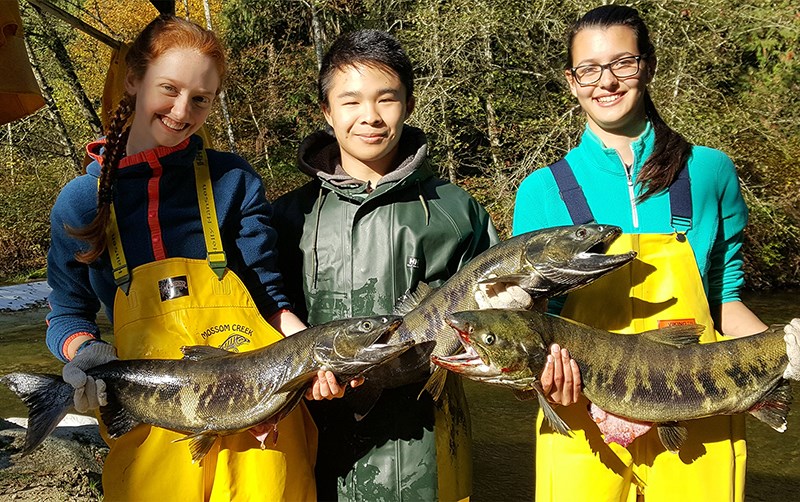More than a dozen students spent a recent sunny day outdoors to learn the ropes of collecting and fertilizing salmon eggs for a hatchery program at Mossom Creek.
Along the way, their teachers say, they learned about teamwork, cooperation and the importance of salmon to the ecosystem.
“Getting away from these screens and all that stuff, and these things we learn in class or things we learn in general are esoteric concepts, and here they are in the real world,” said Diether Malakoff, a Centennial teacher.
Mossom has always encouraged students to participate in salmon hatchery activities — it was a cornerstone of the original salmon program started by founders Rod McVicar and Ruth Foster, who were Centennial teachers at the time.
But for a few years the Centennial salmon program has been in hiatus, although students would occasionally make the trek from the Coquitlam school to the Port Moody hatchery to help out.
Now, it looks as if the program has been revived, according to Malakoff, who said he was approached by a group of students who wanted to get more involved in the hatchery.
After a visit with students last spring, Malakoff decided to get his Class 2 driver's licence so he could drive the school bus and, on Oct. 19, the salmon program participated in the fall egg take at the Alouette River and the egg fertilization process at the hatchery.
“They were out there grabbing the fish and learning about the fertilizing rate, which is 20% in the wild and upwards of 90% at the hatchery, so they were really improving the survival rate of salmon and the kids are wrapping their heads around that,” he said.
The next step will be to establish a course, likely Environmental Science 11, an accredited course in the new curriculum, that students can take that will explore more of the issues around salmon and the environment.
Malakoff said he took on the extra challenge to be a teacher sponsor of the program so he could find ways to introduce more field work into his Grade 9 science course and, along the way, get inspired by his students' enthusiasm.
A Centennial graduate himself, Malakoff said he wants to support the salmon program’s legacy for other students.
“Its an experience that’s super imapactful but it's also not just hanging out, we’re doing work and learning,” Malakoff.
A trio of Heritage Woods students also participated in the work party and Mike Baldus, Science co-op coordinator, said the egg take day — students worked with volunteers and officials to collect eggs, fertilize milt and then mix it to get the eggs started for the hatchery — was a great experience for the kids.
“Especially significant is that we can work in our own backyard to learn what's happening all around us," Baldus said. "Hopefully, this knowledge will then spread into our community and develop a greater understanding and appreciation for the environment around us."
• More information about Mossom hatchery and education opportunities is available at www.mossomcreek.org.



